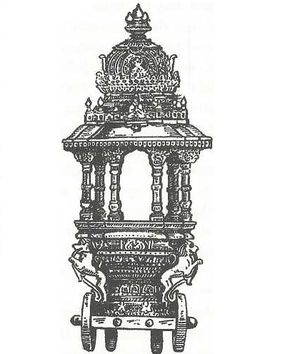Rathayātrā
By Swami Harshananda
Rathayātrā literally means ‘moving the chariot’.
Celebration of Rathayātrā Festival[edit]
The Rathayātrā festival falls on Āṣāḍha śukla dvitīyā. It is the birthday of Lord Jagannātha at Puri in Orissa is a world-renowned event drawing lakhs of people every year. Puri or Jagannāthapurī is one of the four ‘dhāmas’,[1] the other three being Badarī in the north,[2] Dvārakā in the west[3] and Rāmeśvaram in the south.[4]
Beginning of Rathayātrā Festival[edit]
Known as the ‘Puruṣottama-kṣetra’ in the ancient days, the present temple of Lord Jagannātha is said to have been built by the king Indradyumna. The temple with the wooden images of Śrī Kṛṣṇa,[5] Bala-bhadra[6] and Subhadrā[7] must have been in existence for over 1300 years. The wooden images are replaced periodically with new ones, the ‘relics’ inside the old ones being transferred to the new ones, before the former are disposed of according to the directions given in the concerned scriptures.
Significance of Jagannātha Purī Temple[edit]
The Purī Jagannātha temple is perhaps the only temple in India where the mulavigrahas[8] themselves are shifted on to the rathas[9] for the rathotsava.[10] In all other temples, there are separate icons, called ‘utsavamurtis’, which are used for the rathotsava.
Rathas of Rathayātrā[edit]
In the Rathayātrā festival three rathas are used. They are:
- One for Jagannātha, called Nandighosa, 13.5 metres (45 ft.) in height, with 16 wheels of 2.1 metres (7 ft.) diameter
- Second for Balarāma, called Tāladhvaja, 13.2 metres (44 ft.) in height with 14 wheels
- Third for Subhadrā, called Deviratha or Darpa- dalana, 12.9 metres (43 ft.) in height and with 12 wheels.
Rituals of Rathayātrā[edit]
After the ceremonial installation of the deities inside the chariots, it is the privilege of the king of Puri[11] to sweep the chariot of the Lord and pay his homage. Then lakhs of devotees join in the pulling by big ropes, with shouts of ‘Jagannāthakī jay,’ ‘Balabhadrakī jay’ and Subhadrākl jay’. The procession stops at Guṇḍīcābārī, the garden house of the deities. After a stay of seven days, the images are brought back to the main temple on the daśamī day.
The Rathayātrā[12] may be a ritual re-enactment of the journey of Subhadrā, escorted by Kṛṣṇa and Balarāma, to Dvārakā. As per the mythological lore, Subhadrā expressed a desire to see the newly constructed city of Dvārakā and was accordingly taken there by her brothers.
References[edit]
- ↑ Dhāmas means important places of pilgrimage situated in the four cardinal directions of India.
- ↑ It is in Uttar Pradesh.
- ↑ It is in Gujarat.
- ↑ It is in Tamil Nadu.
- ↑ It means Jagannātha.
- ↑ He was Balarāma, Kṛṣṇa’s elder brother.
- ↑ She is Kṛṣṇa’s younger sister.
- ↑ Mulavigrahas means original icons.
- ↑ Rathas means chariots.
- ↑ Rathotsava means chariot festival.
- ↑ He was a descendant of Anantavarma, A. D. 1075-1150.
- ↑ Rathayātrā means travel by the chariot.
- The Concise Encyclopedia of Hinduism, Swami Harshananda, Ram Krishna Math, Bangalore

